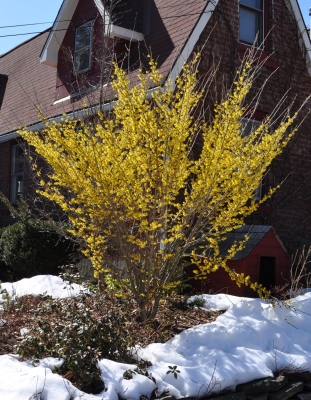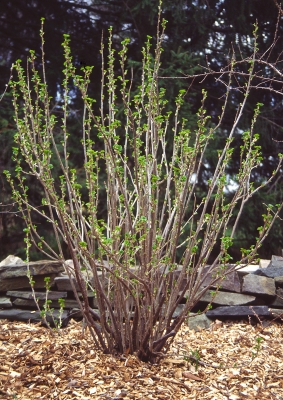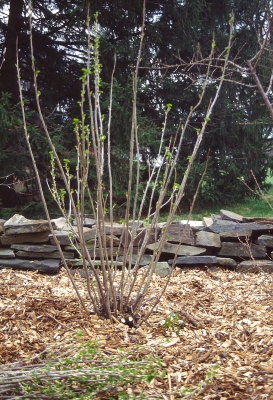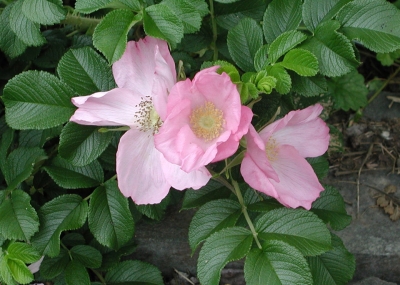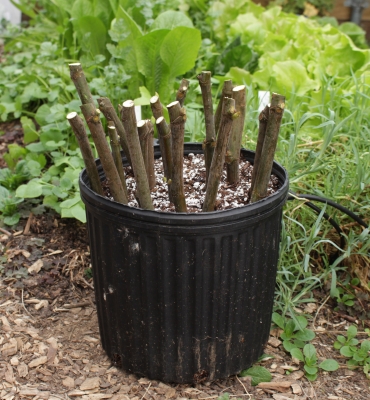To Every Thing There is a Season
/0 Comments/in Books, Fruit, Gardening, Pruning/by Lee ReichPruning is reduced to small steps, in time & process
So many branches, so little time. Or so it seems. Annual pruning is needed to get the best out of most trees, shrubs, and vines, of which there are many here on my farmden.
But wait. My brother once remarked — and the remark rang true — that a large part of feeling overburdened from so much to do comes from thinking about it, rather than doing it. And now that I think about it — if I may be allowed a bit more thought — many trees, shrubs, and vines do not need annual pruning except for size control, in which case a different plant or dwarfer variety could have been planted. My witch hazel shrub is in that hardly-ever-needs-pruning category, as is fothergilla, goumi (an attractive shrub with tasty fruits), mountain laurel, and rhododendron.
Most ornamental trees do not need annual pruning, and the same can be said for ornamental vines, except when they threaten to take down an arbor, fence, or trellis that is lending them support.
Mostly, what needs annual pruning are flowering shrubs, and trees, shrubs, and vines that bear tasty (to us humans) fruit. But exceptions exist even among those edibles. Fruit plants that hardly ever needing pruning include such delicacies as pawpaw, persimmon, huckleberry, juneberry, Nanking cherry, elderberry, and lingonberry.
All shrubs are pruned the same, sort of
I already feel like pruning is under control, without even lifting a finger. And usually I don’t lift a finger to prune until, as is commonly recommended to avoid winter cold damage, after early February, when the coldest part of winter has passed. The last couple of years, though, I decided to go ahead and get a jump on pruning my rather extensive collection of gooseberries and currants. These plants are very cold-hardy so would be expected to laugh off winter cold, even following a December pruning, and they have.
Pruning currants and gooseberries captures the essence of pruning any flowering or fruiting shrub. Shrubs are shrubs because they are shrubby (duh!). That is, their stems are not long-lived but new stems, called suckers, are always popping up through the ground to replace old, decrepit ones. So these shrubs are “renewal pruned.” Old stems are cut away and the number of new stems, if too many, are reduced so that they don’t become crowded as they age.
The questions then become, “How old is too old for a stem, and how many new stems is too many?” The questions are related because shrubs whose old stems perform well in terms of fruit or flowers also tend to make fewer suckers, and vice versa. The easiest way to approach shrub pruning (and the way it’s detailed in my book The Pruning Book) is to group shrubs into one of four categories. At one end of the spectrum are shrubs that flower or fruit well on very old wood and make few suckers — and, hence, are in the aforementioned hardly-ever-needs-pruning category. At the other end of the spectrum are shrubs that flower or fruit only on new stems, such as butterfly bush, so can have every one of their stems lopped to ground level every year.
A now I do it, prune currants & gooseberries
The other day I stopped thinking about pruning my gooseberry shrubs and, instead, approached them with lopper and hand shears and a new-found sense of having all the time in the world. Gooseberries fruit best on stems that are 2 and 3 years old. Pruning is straightforward. Merely lop to the ground any stems more than 3-years-old (they were 3-years-old last season and bore fruit) and reduce the number of new stems to about a half-dozen of the sturdiest, most upright ones. The ideal, pruned gooseberry shrub, then has about a half-dozen each of 1, 2, and 3-year old stems. A shrub never becomes a tangle of stems nor has old, decrepit, unproductive ones.
Red, white, and pink currants get pruned exactly the same as gooseberries; black currants, though, are a whole ‘nother animal. They bear best on 1-year-old stems and, to a lesser degree, 2-year old stems. So for the black currants, I lopped back to the ground any stems more than 2-years-old as well as some 2 year olds and thinned out new, 1-year old stems, again to the best half-dozen.
How do I know the age of any shrub’s stem? I could count back the age of the various side branches starting at their tips. That would be tedious. The thickness of the base of a stem and the appearance of the bark are just as telling. Old bark is darker and, often, peeling.
After pruning any shrub I go over the plant to remove or shorten stems that will droop so low as to set their fruits on the ground. Especially with strictly ornamental shrubs, I also lop back any stems shooting gawkily skyward or otherwise looking out of place. And then, for any shrub, ornamental or fruiting, I step back to evaluate and admire my handiwork.
The why, how, and details of pruning any plant
For more about how to prune everything from houseplants to delphiniums to maples to raspberries, check out my book, The Pruning Book.
Live, On Stage Now!!!
I’ll be giving a number of lectures at various venues over the next few weeks. For a listing of what and where, see Lectures.
NOTES TO MESELF
/9 Comments/in Fruit, Gardening, Pests, Planning/by Lee ReichOf Mice, Disease, To Grow, and Not To Grow
Despite rain, some snow, and temperatures that dipped below 10°F, the whole bed of endive was lush and green. A low tunnel of porous, light fabric and clear plastic held aloft by wire hoops kept the worst of the weather at bay. As I reached in to harvest a head, no knife was necessary; the head lifted, unattached, off the ground. Mice have been at work again!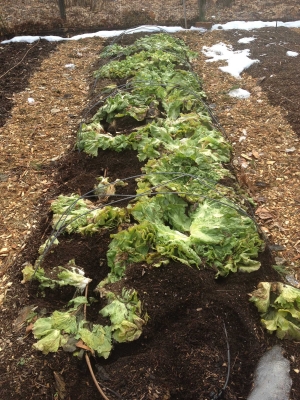
If it’s not one thing, it’s another. A timely sowing of endive seeds (early July) gave sturdy seedlings that were transplanted (early August) into compost enriched soil to present (by September) a beautiful bed of wall to wall greenery. The beds were covered for cold protection in November.
What a cozy home that bed became for mice. The tunnel provided not only food and lodging but also cover from the hungry eyes of local hawks. The mice ignored endive’s leaves, instead devouring the stout, fleshy portions of root and stem at the base of almost every plant.
Note to myself: Next fall pre-empt mice by getting a supplemental cat or two and/or setting traps within wooden boxes having mouse-sized entry doors.
Rip Out the Clem’s, Plant New Ones
Another note to myself: Replant clematis.
Over the years I’ve accumulated a number of varieties of clematis. The vines barrel up and over fences and trellises clothing them in sumptuous blooms. Blossoming has diminished over the years, the culprit being clematis wilt, a fungal disease that turns leaves and stems black. It doesn’t usually kill the plant but a clematis without flowers and with blackened leaves and stems is not a pretty site.
Clematis and I are not finished. In the next few weeks I must sit down and seek out sources for native clematis species and their hybrids. Their flowers are smaller but they are resistant to wilt. Scarlet Clematis (Clematis texensis) is definitely on my list, as is Rock Clematis (C. columbiana, sometimes listed as C. occidentalis var. columbiana), and the hybrids Betty Corning and Étoile Violette. The choices don’t stop there because two breeders on the other side of the Atlantic have come up with a whole series of wilt-resistant clematis, known as Evison-Poulsen series.
To Grow or Not To Grow, That is the Question(s)
More notes to myself on plants to grow and not to grow next year.
My zinnias looked a little unusual this year, unusually pretty, each flower with a single row of yellow petals radiating from a brown eye. Also unusual in being very compact, long lasting, and not marred by the powdery mildew of most zinnias. Last year I had just a few of these hybrid Zahara Yellow Improved zinnias in the vegetable garden; next year I’m planning for enough to make a bold, yellow line along each edge of the main path.
It was a great year for peppers, and the greatest, for flavor and production, were Carmen, Sweet Italia, and Pepperocini. Great for production but not so great for flavor was King of the North, which won’t be invited back. In its place, I’ll be inviting Bridge to Paris pepper, recommended by a knowledgable friend.
Cardoon, the variety Hunchback of Nice, was better than expected but not good enough to justify the growing again of last season’s 10 plants. Each plant is bold and striking with upright, to 3 feet or more, blue-green leaves, so my plan is to grow only 2 or 3 as ornamentals from which I’ll steal occasional leaves for eating.
Meserve holly bushes that I planted many years ago have grown large to create a solid wall of lustrous, spiny leaves. That’s nice. Even nicer would be red berries against that verdant backdrop. Close inspection of the flowers last spring indicated that all the plants, contrary to what was ordered, are females. One male, which I will order, can sire them all so that in a few (very few, I hope) years, red berries will liven up the scene in winter.
I completely forgot to plant ginger this year. Yes, ginger, that tropical plant which has captured the interest of many small farmers. I could never understand the big deal about ginger until I experienced the tenderness of freshly harvested, red blushed baby ginger. Not that mature ginger could anyway be harvested in the short growing season this far north. My plan is to buy a ginger root in March, divide it up and pot up each section, then keep the pots warm and moist to give the roots an early start for a good harvest of baby ginger.
Brussels Sprouts, the variety Gusto, were a rousing success, perhaps too rousing because we still have 6 stalks perched in a bucket in the cool mud room and awaiting dinners. Four to six plants will be plenty for next year.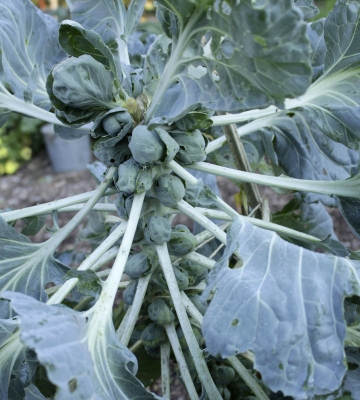
Not every vegetable needs to be loved by everyone. Next year, and in years hence until I forget what they taste like, I will not be growing broccoli or beets.
NICE HIPS, BUT WHOSE?
/4 Comments/in Flowers, Fruit, Gardening/by Lee Reich2 Contenders for Hips and Rabbi Samuel Redux
As I walked along the beach, I took a look and my first thought was “Nice hips.” But what about the flowers? I’d have to return to the plant next summer to find out, a problem since I was 4 hours from home visiting a relative in Rhode Island.
Most of the roses you see growing seaside are Rosa rugosa. Common names for this plant are Japanese rose, indicating its origin, saltspray rose, indicating its tolerance to beach sand, and rugose rose. “Rugose” means “wrinkled,” which is what leaves of R. rugosa are.
The particular planting of nice-hipped roses staring back at me did not have rugose leaves. What’s more, the hips were about 3/4 of an inch across and bright red. Hips of rugose rose are usually an inch or more across and orangish-red. With this slightly different morphology and the fact that rugose rose is listed as an invasive plant, I assumed that the nice-hipped roses, recently installed as landscape plants, were another species.
With such nice hips, the plants could possibly be dog rose, R. canina, the other rose species valued for its hips. The lack of sepals on the hips also pointed the finger at dog rose. (Rugose rose hips have persistent sepals.) A even closer look would have nailed it; rugose rose’s stems have numerous prickles throughout their length while bold, large, wide, downward-facing thorns line dog rose stems. But I didn’t look closer.
Dog rose, although much less frequently seen, is also considered invasive in some places.
Sowing Seeds for More Hips (and Flowers)
As potentially invasive plants, rugose rose or dog rose should be easy to grow from seed. But no. I’ve propagated roses from seed, and it’s a slow process.
Rose seeds, like those of most other fall-ripening seeds of temperate zone plants, have a physiological dormancy that prevents their immediate sprouting, the consequence of which would be death from cold. So they just sit in moist earth until they have experienced a number of hours of chilly temperatures — 30 to 45° F is ideal — before sprouting, at which time winter has presumably given way to spring weather. Instead of moist earth, that chilly habitat could be within the refrigerator in a plastic bag filled with peat moss and perlite.
But rose seeds have another impediment to germination: a tough seed coat. Plant the seed outdoors and shoots might not poke through the surface of the ground for 2 years. The first winter and summer are spent softening the seed coat, making it permeable to moisture. Beginning the second fall, chilling hours begin to accumulate so that by the second spring, the seed can awaken and grow.
I did pluck a few fruits from that Rhode Island, nice-hipped rose bush, and plan to make new bushes. But I’m too impatient to wait 2 years. “Scarifying” the seeds is a quick way to make the seed coats more permeable. Nicking them with a wire cutter does the trick but would be difficult with such small seeds. An hour or so in warm, concentrated sulfuric acid — followed by a thorough rinsing in water — is likewise effective but a bit dangerous. I’ll follow Mother Nature’s lead and soften the seed coats by keeping the seeds warm and moist. No matter how the seed coat is softened, subsequent cool, moist conditions are still needed before the seeds will sprout.
There’s barely time to get those seeds growing this spring. Two months in moist warmth followed by 2 to 3 months in moist peat and perlite in the refrigerator should awaken them. It’s exciting to check the bag in the refrigerator because, once mechanical and chemical barriers to germination have been overcome, a bag of seeds is usually transformed to a bag of white root sprouts, all at once, as if a switch had been turned on.
The Rabbi Multiplies
I’ll have to make up some extra peat-perlite mix. Cutting all the vertical shoots of Rabbi Samuel fig espalier back to the horizontal arms of the permanent “T” framework have yielded a pile of long stems. I can’t bear to throw them away because every foot-long section has the potential to make a whole new plant.
The rooting media for these hardwood cuttings? Peat and perlite again. A bunch of the stems in a deep pot with just their top buds up out of the peat mix should sprout and root by spring.
Not sure what I’ll do with all the resulting fig plants.
So Many Roses, I Hope
I’m also not sure what I’ll do with all the anticipated rose seedlings, especially since I’m not even sure of their species. I did telephone the public works department of the Rhode Island town where the roses were planted and was told that they were Rosa rugosa. I think they are wrong.
No matter: Rosa rugosa is one of the most fragrant roses with deep pink, sometimes white, flowers that are borne all summer long. Also, like dog rose, with nice, fleshy hips, good enough fresh and excellent for jam and tea.

